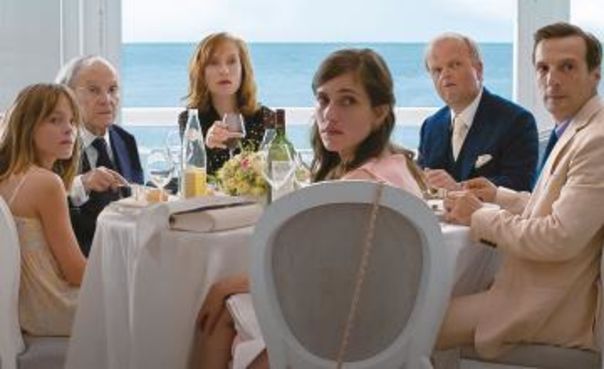Review: HAPPY END
By Mina Stanikić

After premiering at this year’s Cannes Film Festival, Haneke’s new film HAPPY END (2017) was screened as part of the Kinoscope line-up at the 23rd Sarajevo Film Festival. The whole Kinoscope selection of titles, including the aforementioned, comes as a relief as it shows global productions – in contrary to the festival’s Competition sections showing regional films, that, logically, yet unfortunately, deal mostly with the troubling past of Southeast Europe and the Southern Caucasus. However, the relief in HAPPY END ends with the fact that the film does not deal with local Balkan issues, as Haneke stays loyal to his well-known disturbing manner of storytelling.
HAPPY END is a family drama that does not have a happy end, neither a happy beginning. The opening scene serves as prologue, and, as it seems for quite a while, it is completely detached from the rest of the film. The camera is not the one of DOP Christian Berger, to whom Haneke returns after having worked with a different cinematographer for AMOUR (2012), but of an anonymous phone recording with a woman apparently being stalked. The messages popping up on the screen give the footage the connotation of a social media video, but also point out that the person filming knows every step of the woman being followed, which contributes to the stalking impression. It is only later on that we learn who the person behind the camera was: Eve, a 13-year-old girl, daughter of the woman filmed.
There is no main protagonist in HAPPY END, but if there is one character that might be receiving more of Haneke’s attention than the others, it is Eve, who is bound to live with her father Thomas (Mathieu Kassovitz) after her mother is hospitalized early on in the film. Thomas, who has a new family, is, on the other hand, bound to live with his sister Anna (Isabelle Huppert) and their dementia-suffering father Georges (Jean Louis Trintignant). Together, they form the highly dysfunctional Laurent family clan, in which Eve is unwillingly thrown.
The Laurent family itself becomes a plot making HAPPY END a drama full of Haneke’s signature pressure on the viewer who might be unable to point out where exactly the horror of discomfort begins or ends. At first it is challenging to understand the relations between the characters, of whom we only see little, with Haneke rapidly changing the focus from one to another. This might be seen as the film’s drawback, as throughout the whole first hour it seems that the clumsy narrative stumbles down an unknown path with no clue of where it is heading. Having no main character and focusing on all of them for a short time makes the first hour of the film look rather like an omnibus, with all the stories only loosely connected to each other.
Yet, Haneke does not disappoint. After a while, all these stories confluence together with Eve flowing in the very center of that stream, as the one more lucid than the others, understanding her surrounding to the fullest, despite being the youngest. With other fragments of the film also shot with Eve’s phone camera, Haneke decides to observe the family through the eyes of a teenager captured in today’s world of social media. As in BENNY’S VIDEO (1992), Haneke returns to the defence mechanism of detachment via mediatizing the events, rather than looking at them. In HAPPY END he adds the context of the undoubtedly crucial impact of social media nowadays, which makes the film closer to the viewer, as “sharing”, “posting” and “liking” seem to be inevitable for today’s youth. Eve, being only 13, might not be able to figure out the vast capacity of the content available online, yet she feels the need to film and share the private life of her family, and hers, with other youngsters on the internet.
There is no writing about HAPPY END without mentioning an obvious reference to AMOUR which also includes Eve, as Haneke returns to the theme of tormented old-age life, but now from a different perspective. Whereas the old woman in AMOUR had her husband (also played by Trintignant and also named Georges) take care of her senseless bedridden life, Georges of HAPPY END sees Eve as a perfect solution to consensual suicide after being met with refusal from the adult world. Even though never said out loud, Eve understands her role; the contradiction that is “help” defined as “terminating life” is chilling enough, but knowing it will be done by a little, naïve looking girl, makes the chill even stronger.
The unhappy end of the film returns to the unhappy beginning, with the same phone camera. The confused yet emotionless look of family members running, trying to save the life of Georges, is the last thing we see in the film, and probably the scene that will be deeply engraved in the viewers' memory of the film. For everyone who expected the true soft horror that Haneke usually used to make in his long career, this film might be a disappointment. For the rest who can bear with the fact that he is also allowed to make films less “body drilling” (as the DOP calls it) and more subtle, HAPPY END comes as a satisfying follow up to AMOUR.

